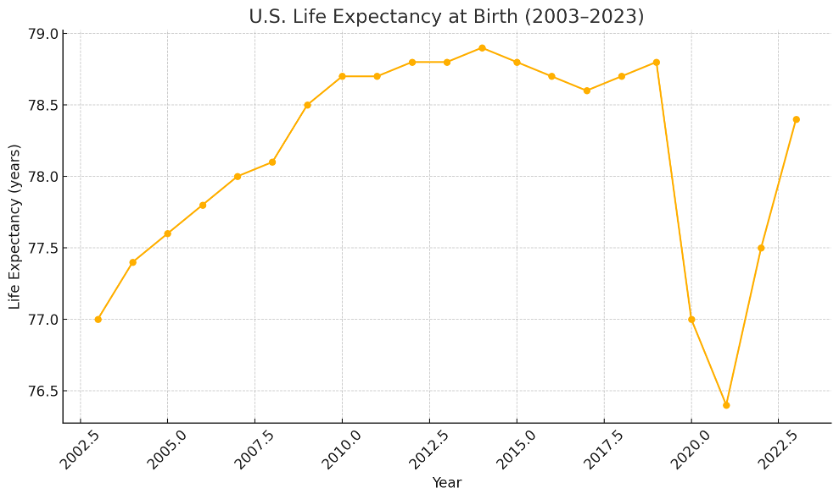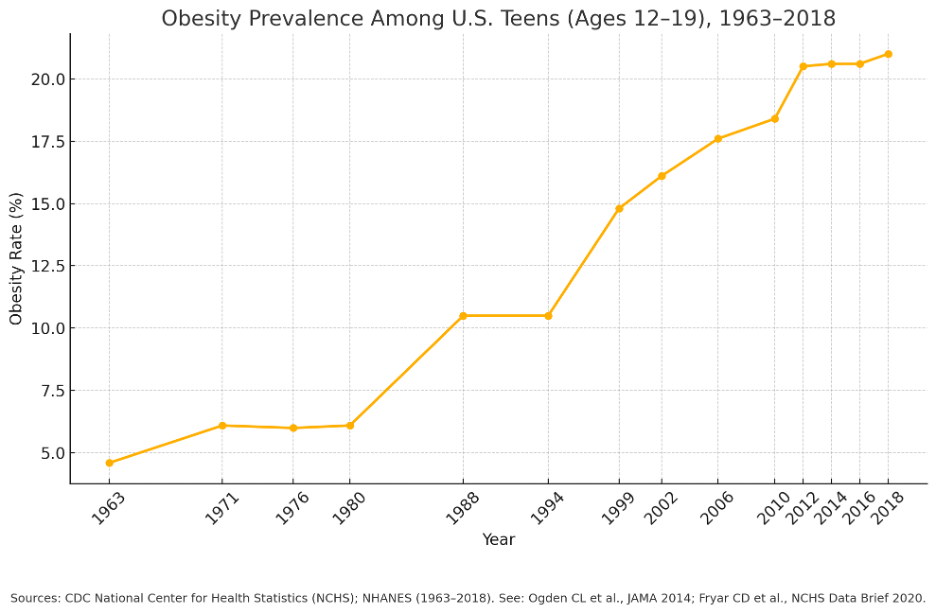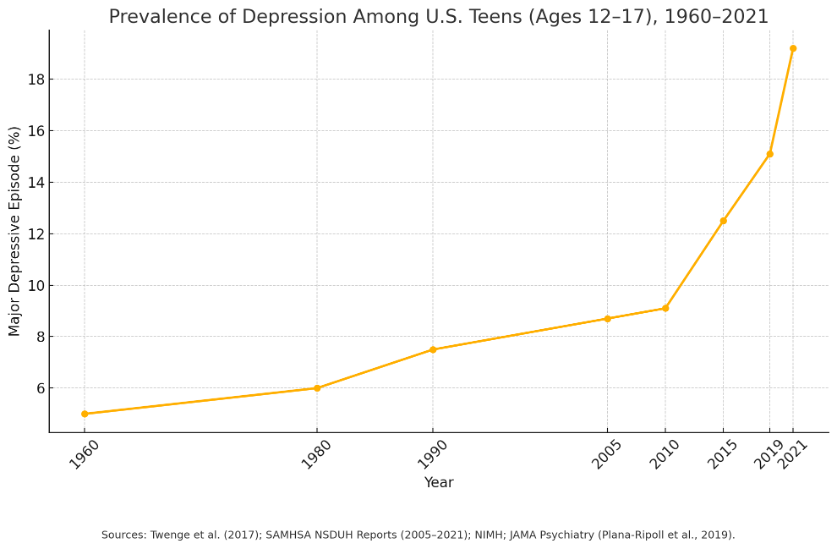Life Expectancy in the United States - Declining for more than a Decade
- Full Scope
- Jul 28
- 5 min read
There is a buzz about longevity. Many people feel that we are on the brink of a lifespan revolution. There is talk of making living to 100 the new norm. But the reality is just the opposite.
So, I thought I should.
The truth:
Life expectancy is actually declining. Since its peak in 2014, the average lifespan in the United State has declined about 0.5 years. This may not sound like much. But considering the trend has been consistent and represents the average of a population of over 300 million people, it’s a hug deal.
My big fear…..This is just the beginning and that this trend will continue.
Why? Because even though we have more and better medical technology than ever, our environment is increasingly unhealthy. The world has become obesogenic, diabetogenic, and addicted. This is crippling our ability to live long and live well.
Figure 1: Life Expectancy from Birth (2003 – 2023)

Life expectancy increased dramatically from 1900 to 2010 (47.3 years to 78.7 years). This almost doubling of the average human lifespan was extremely impressive. Things like sanitation (clean water), better maternal fetal care, childhood immunizations, accident reductions, and antibiotics supercharged our ability to live longer. Wow, for a while we crushed it.
Life expectancy peaked in 2014 at 78.9 years. Since then, it has declined. Essentially from 2010 to 2023, things were mostly flat. In 2019 life expectancy declined drastically (by almost 2 years). Some of this was due to COVID19 and increased death tolls during the pandemic, from the virus, suicide, homicide, and chronic illness. In fact, 2020 saw a 30% increase in homicide rates, the largest one year increase in US history. But even though there has been a rebound of 1.5 years, the downtrend continues. We are back down to 2009 levels as of 2023. Yikes……
Am I optimistic about that this trend will turn back around…..NOT AT ALL!
Life expectancy is a very late marker of health and prosperity. Essentially it is the data point that moves last. For instance, we would expect to be able to see rates chronic disease rising, long before we see a decrease in life expectancy. And…..We see just that.
Why I think that life expectancy is likely to stay flat or even continue to downtrend:
The burden of chronic disease is rising sharply. I see this in my clinical practice as well as in epidemiological data. Chronic disease, shortens life.
Obesity rates in everyone, but especially teenagers continues to sore upward
Mental health problems in everyone but especially young people continues to sore upward
Infertility is rising, this is a reflection of our poor overall health.
Our environment is increasingly more unhealthy. More ultraprocessed foods, more sedentary lifestyles, less community, less willingness than ever to do the work and stay healthy.
Let's Dive into Obesity
Being obese is a major risk factor for multiple chronic diseases including Diabetes Type 2
4% of adults in 1990 had DM2, by 2020 this number increased to 12%
Signs of metabolic syndrome or pre-metabolic syndrome (part of the same spectrum of disease as diabetes type 2) are estimated by many popular sources to affect as much is 90% of the adult population. Sadly, my clinical practice supports this number.
When I was in school, it felt like maybe 1 out of 20 kids was “the fat kid”. Now its more like 1 in 5. This number is growing with each generation.
Obesity tends to increase with age. So teen obesity is particularly concerning.
In the blog post, I show a graph on teen obesity rates from 1963 to 2018. Honestly, Its F***ing scary
Figure 2: Teen Obesity Rates in the USA, 1963 to 2018

From < 5% in 1963, to > 20% in 2018
We are on course for disaster.
To illustrate this further, obesity is the statistic most coorelated with average life expectancy in each state. For instance Mississippi, Louisiana, and Alabama have obesity rates of 39-40% and life expectancies of 71-75 years. Compare this to Colorado. Obesity rate of 24% and a life expectancy of 80+ years. These trends hold firm across all states. Sadly obesity continues to rise in every state year over year.
About 40% of US adults are now obese according to BMI. In less than 1 decade, not being obese, will make you a minority.
Say goodbye to fat shaming and hello to skinny shaming.
What about Mental Health?
Rates of depression in teenagers has skyrocketed as well
Depression has a very negative impact on ability to work and contribute to society
Moreover, people with depression are much more likely to have serious chronic diseases and adverse health events. We are even talking serious increases in things like heart disease, heart attacks, and strokes.
People with depression live an average of 7 years less than those without. When a person has depression + comorbid conditions (like diabetes), life span may be shortened AS MUCH AS 20 YEARS.
Take a look at this graph on depression rates in teenagers…..YIKES
Figure 3: Depression Prevalence in US Teens, 1960 to 2021

From about 5% of teens in 1960 to almost 20% in 2021. OMG. Not looking good. What is really interesting to me is how drastically the rates have increased since 2010. The very same year life expectancy started to level off. From 9% in 2010 to 20+% now.
The most common reasons cited for this increase starting in 2010 are the rise in smart phones and social media during this time. The reasons are likely multi-factorial, but all fit nicely under the umbrella of an increasingly unhealthy environment.
Infertility
This is another huge one. We are talking society ending scary. Fertility rates are plummeting. But, I will have to save this for another episode.
Summary
Life expectancy has been flat or declining since 2010
Obesity and depression rates in teens has skyrocketed. These problems are also increasing in adults
Since obesity and depression are major risk factors for chronic disease and shorter lifespan, we are in real trouble
So, I don’t get all this talk about longevity and our population living longer. The trends show just the opposite.
What we need to do
Get back to the fundamentals; healthy real food (and much less total intake), movement, purpose, hard work, community, and education.
We know the above leads to longer and more productive lives.
These things must be soute after by individuals, communities, local and federal governments.
If we don’t make major changes fast, society will fail under the weight of our growing unhealthiness…..No pun intended.
References
· Centers for Disease Control and Prevention (CDC), National Center for Health Statistics (NCHS)
· National Health and Nutrition Examination Survey (NHANES), various cycles (1963–2018)
CDC/NCHS, National Vital Statistics Reports: U.S. Life Tables, 1900–2010
· Plana-Ripoll et al., 2019 (The Lancet Psychiatry)
Mental disorders are associated with a 10-year reduction in life expectancy on average.
· Cuijpers et al., 2014 (Meta-analysis)
Major depression is linked with increased all-cause mortality across global populations.
· Walker et al., 2015 (JAMA Psychiatry)
Mental disorders account for 14.3% of global deaths, often via indirect routes like heart disease and suicide.
· Ogden CL et al., Prevalence of Childhood and Adult Obesity in the United States, 2011–2012. JAMA. 2014;311(8):806–814.
· Fryar CD, Carroll MD, Afful J., Prevalence of Overweight, Obesity, and Severe Obesity Among Children and Adolescents Aged 2–19 Years: United States, 1963–2018. NCHS Health E-Stats, 2020.
· Data derived from multiple cycles of the National Health and Nutrition Examination Survey (NHANES), CDC/NCHS.
Twenge, J.M. et al. (2017). Increases in Depressive Symptoms, Suicide-Related Outcomes, and Suicide Rates Among U.S. Adolescents. Clinical Psychological Science.
Plana-Ripoll et al., 2019. Life years lost associated with mental disorders: a nationwide registry study. JAMA Psychiatry.








Comments